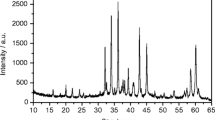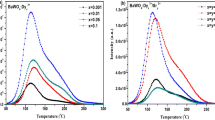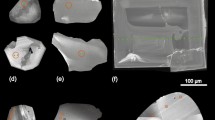Abstract
The photoluminescence (PL) of zircon is characterized by a broad structureless spectral band down to 4.6 K, which does not enable correct interpretation of the nature of the luminescence centres (LC). By applying step-like thermal treatment, a radiation treatment and timeresolved spectroscopy, seven pure bands were separated and their individual spectral-kinetic properties were determined.
The yellow PL is connected with three LC:
-
1.
Intrinsic defects of the (SiOm)n− type, which are generated by radioactive decay of U and Th;
-
2.
Impurity defects (MeOm)n− (Me−Mo, V) associated with charge compensators, probably the Fe3+ and Ti3+ (clusters of these LC generate a yellow-orange shoulder);
-
3.
Impurity defects (UO2)2+.
The blue PL is connected with impurity defects (TiOm)n−.
The red PL is connected with impurities Fe3+ and Ti3+.
These LC are characterized by a different thermal stability and response to ionizing irradiation. This work allows us to propose some practical applications in the fields of dating, dosimetry and genetical mineralogy.
Zusammenfassung
Die Photolumineszenz (PL) von Zirkon ist durch eine breite, unstrukturierte Spektrenbande bis 4.6 K gekennzeichnet, was keine korrekte Interpretation des Wesens der Lumineszenzzentren (LC) ermöglicht. Durch Anwendung einer schrittweisen Wärmebehandlung, einer Bestrahlung und zeitabhängiger Spektroskopie wurden sieben reine Banden erhalten und deren individuelle spektral-kinetischen Eigenschaften bestimmt.
Die gelbe PL steht mit drei LC in Verbindung:
-
1.
innere Defekte vom (SiOm)n−-Typ, die durch den radioaktiven Zerfall von U und Th hervorgerufen werden;
-
2.
Verunreinigungsdefekte (MeOm)n− (Me − Mo, V) in Verbindung mit Ladungskompensatoren, wahrscheinlich Fe3+ und Ti3+ (Cluster dieser LC erzeugen eine gelb-orangene Schulter);
-
3.
Verunreinigungsdefekte (UO2)2+.
Die blaue PL steht in Verbindung mit Verunreinigungseffekten (TiOm)n−.
Die rote PL steht in Verbindung mit Fe3+ und Ti3+ Verunreinigungen.
Diese PL sind durch eine verschiedene thermische Stabilität gekennzeichnet und sprechen auf ionisierende Strahlung an. Vorliegende Arbeit erlaubt den Vorschlag einiger praktischer Anwendungen in den Bereichen Altersbestimmung, Dosimetrie und genetische Mineralogie
Similar content being viewed by others
References
G. Blasser, Structure and Bonding, 42 (1980) 1.
M. Gaft, L. Bershov and A. Krasnaya, Phys. Chem. Miner., 11 (1985) 255.
M. Gaft, A. Rogozin and V. Rassulov, Miner. Jurn., 9 (1987) 63 (In Russian).
M. Gaft, ‘Spectral-kinetic characteristics of luminescence of minerals under laser excitation’, VIEMS, Moscow 1989, (In Russian)
A. Krasnobayev, S. Votyacov and V. Krochalyov, ‘Spectroscopy of zircons: properties and geological applications’, Nauka, Moscow 1988. (In Russian)
A. Marfunin, ‘Spectroscopy, luminescence and radiation centres in minerals’, Springer, Berlin 1979.
I. Shinno, J. Jap. Ass. Miner., Petrol, and Econ. Geol., 11 (1986) 433.
Author information
Authors and Affiliations
Additional information
The experimental part of this paper was carried out while the author worked at All-Union Institute of mineral resources (Moscow, Russia).
The author expresses deep appreciation to Prof. Kirsh Y. for his helpful discussion, and to V. Rassulov and V. Zukova for their great help.
Rights and permissions
About this article
Cite this article
Gaft, M. Application of thermal treatment of zircon for the interpretation of luminescence centers. Journal of Thermal Analysis 38, 2281–2290 (1992). https://doi.org/10.1007/BF02123981
Received:
Revised:
Issue Date:
DOI: https://doi.org/10.1007/BF02123981




